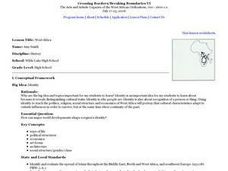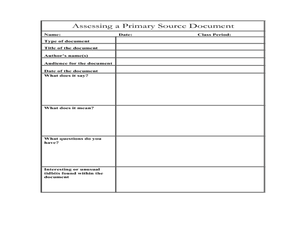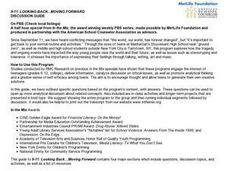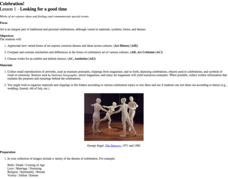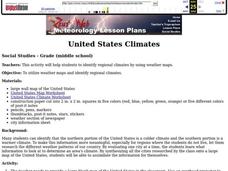Curated OER
The People of Kansas: Where Did They Come From and Why Did They Come?
Pupils research and discuss the reasons why early settlers emigrated to Kansas. They, in groups, analyze census district reports from the 1850's and then identify the advantages and disadvantages of using this information as research.
Curated OER
Hate Crimes Legislation
Students investigate hate crime legislation. In this hate crime lesson, students examine the Matthew Shepard and James Byrd, Jr. Hate Crimes Prevention Act Students explore the fine between hate crime legislation and First Amendment...
Curated OER
Progress
Students discuss how they believe Australia has progressed over time. In groups, they use the internet to research events in the country's history. They discover how democracy in the country continues to develop and analyze the race...
Curated OER
Constructing a Timeline of African History
Young scholars create a timeline of African History. In groups, they research and describe eight different important periods in the country's history. They apply this information to compare and contrast them and how it has allowed...
Curated OER
The People of Kansas: Who Are They and Why Are They Here?
Students examine the settlement patterns of the Kansas Territory. In this Kansas history lesson, students analyze primary documents from the pioneers in the territory. Students write letters or perform skits that feature their findings.
Curated OER
The Empires of Africa
Learners, in groups, compare and chart the different African kingdoms and city-states. They write a short essay detailing the aspects of African history that most fascinates them.
Curated OER
9-11: Looking Back...Moving Forward
Students watch and discuss a video about teens living in and around New York and how 9-11 changed their lives. They answer discussion questions, read and discuss newspaper/magazine articles, take a self-test on depression, and create a...
Curated OER
Understanding Religious Clothing
Young scholars explore the concept of religious clothing. For this Teaching Tolerance lesson, students examine misconceptions and stereotypes regarding religious clothing as they read selected articles and discuss their impressions.
Curated OER
Arab Americans: In the Aftermath of the Terrorist Attacks on the U.S.
Students examine the effects of the terrorist attacks in 2001. In this lesson on discrimination and the dangers of stereotyping, students will expand their understanding of stereotyping in contemporary society and compare in to similar...
Curated OER
HUMAN/ENVIRONMENT INTERACTIONS: CLIMATE
Students explore the various global climates and apply cultural adaptations of the peoples in various zones due to climate.
Curated OER
Who Needs a Dress Code?
Students create a poster showing examples of appropriate and inappropriate student grooming and attire. They write comments explaining the need for each rule.
Curated OER
Native Americn Religious Beliefs and Practices
Young scholars research how religions are created and how they influence the way people live. They identify the religious beliefs and practices of the Inuit, Lakota, Apache, Navajo and Iroquois Native Americans. Students find the...
Curated OER
Australia's Religious Diversity
Students identify major world religions and forms of spirituality and recognise the religious diversity of communities in Australia. They brainstorm for the definition of religion. Students brainstorm to come up with a list of religions.
Curated OER
Children's March Teacher's Guide, Activity 6
Students explore the role of gender in the Civil Rights Movement. In this Children's March lesson, students watch "Mighty Time: The Children's March" and respond to the provided discussion questions that accompany it. Students create...
Curated OER
Where There's Smoke
Pupils view photographs to help them see how people live in rural Nepal. In groups, they imagine what it would be like to grow up in this type of community with little food and identify the problems associated with the Nepalise homes. ...
Curated OER
The African-American Experience in the 20th Century through the Art and Life of Jacob Lawrence and the Novels of Bruce Brooks a
Students attempt to answer how African-American, Latino, and white students address race relations in the United States in the future.
Curated OER
Changes of Musical Elements in Popular Music Through the Decades
Students probe samples of European classical, American jazz, and rock and roll to analyze the similarities and differences. The styles and form of these three types of music are examined for tempo, timbre, and rhythm.
Curated OER
Lincoln and the Republicans: The Cause of the War?
Students evaluate the impact of the Republican party in creating a Southern philosophy of secession. They analyze causation concerning the Southern philosophy of secession.
Curated OER
Outdoor Survival
Students identify the seven basic needs for survival. They describe the symptoms and treatment for frostbite and hypothermia. Students compare and contrast the value of different materials in a survival situation. They use their...
Curated OER
Bill of Rights: Rights and Responsibilities
Students explore the Bill of Rights. In this U.S. Constitution instructional activity, students consider the individual liberties outlined in the Bill of Rights as they read the provided handouts and complete the provided worksheet...
Curated OER
Who is Who in the Old West?
Students consider the backgrounds of those who settled the Old West. In this Westward Expansion lesson, students participate in a simulation that requires them to role play miners, ranchers, Native Americans, Chinese, African...
Curated OER
Many Ways of Seeing
Investigate themes and issues in art such as the concept of originality, interpretation of visual language, symbolism, and examination of the categories of fine art and folk art.
Curated OER
Celebration!
Use a five-lesson unit to investigate how different cultures use art for common purposes, such as the marking of special events, celebrations, and the validation of human experience.
Curated OER
United States Climates
Pupils identify regional climates by using weather maps. They, in groups, locate and mark their city on the small map, then go to the larger map to locate and mark their city when they are called upon by teacher.



